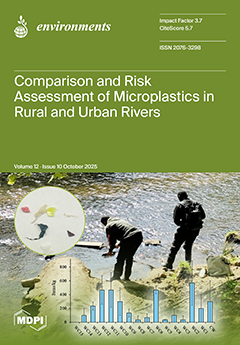Riverbank height plays a potentially important role in hydrological dynamics and pollutant transport, yet its influence on long-term water quality trends remains insufficiently documented. This study explores possible relationships between riverbank height variations and the Global Pollution Index (
) in the Timiș River, Romania, over eleven (11) years (2013–2023). A dataset of 17 physicochemical parameters—including BOD
5, COD-Cr, dissolved oxygen, nutrients (N and P species), heavy metals (As, Cr, Cu, and Zn), detergents, and phenols—was used to tentatively assess ecological status. The results suggest that, despite a maximum riverbank elevation change of ~11 cm between 2020 and 2025,
values remained within a relatively narrow range (1.98–2.56, mean 2.19), pointing to persistent but moderate anthropogenic pressure. The highest index value (2.56, in 2016) coincided with a transient pollution event, whereas subsequent years stabilized around 2.0–2.3, which may reflect chronic diffuse pollution. Correlation analysis revealed strong associations between BOD
5 and conductivity (r = 0.76, linked to organic loads), COD-Cr and heavy metals (r = 0.79, suggestive of industrial influence), and total nitrogen and nitrate (r = 0.97, related to agricultural inputs), appear to outline distinct source-related signatures. This study offers preliminary evidence that even modest riverbank fluctuations may influence hydrodynamics and the fate of pollutants, while basin-scale water quality seems to remain largely governed by diffuse pollution sources. By integrating long-term geomorphological monitoring with multi-parameter water quality data into a composite index (
), our work sketches a potentially innovative framework for diagnosing pollution drivers. The findings underscore the importance of incorporating riverbank morphology into EU Water Framework Directive monitoring, alongside GIS, IoT, and machine learning tools, could contribute to more adaptive river basin management.
Full article





